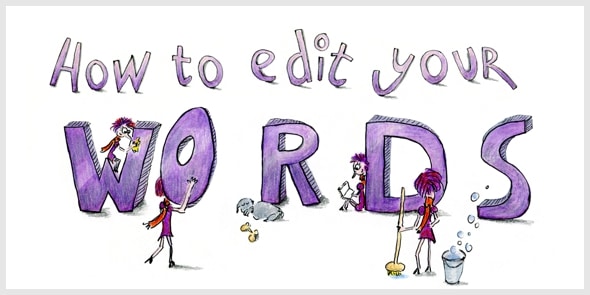
When Hayley reads her draft text, she feels disappointed.
Her writing doesn’t make her heart sing.
She knows her tips are valuable—they’ll make her readers feel less stressed and more productive. Hayley inspires her readers to slow down, get more done, and feel good about themselves.
Her content is good. The flow feels right. She’s corrected typos, and ironed out grammar mistakes.
But still …
Her writing feels a bit off.
Her words don’t seem to shine as brightly as the content from the pros she admires.
What can she do?
Self-editing can feel tricky
You need to step back a little, and review your content through the eyes of a reader.
When does your reader stumble? When does he fail to get your message? When does he nod off?
Editing is like sandpapering away small blemishes so your content feels smooth to readers. You change a word here and there to make the meaning more accurate, to cut the flab, to smooth over transitions.
When editing, you also have to consider yourself: Does your writing voice suit you or do you need to fine-tune your words?
Edits are often subtle changes, and sometimes these changes are personal—you choose a word because it suits you and your writing voice better.
Editing tasks include:
- Check words for accuracy to communicate your message with piercing precision
- Cut the flab so your writing becomes concise
- Add examples or a vivid explanation where your content feels abstract
- Pay attention to smooth transitions from sentence to sentence, and from paragraph to paragraph
- Remove gobbledygook so you sound human
- Play with emotional, sensory, or unusual words to add a dash of personality
But how exactly does self-editing work in practice?
Everyone’s draft texts are different. For instance, I’ve practiced concise writing so much, that even my first drafts are pretty concise. I more often add text rather than delete flab. For you, the opposite might be the case.
Below you’ll find three draft paragraphs (from my post about business manifestos) and I explain exactly how (and why) I edited these paragraphs. You can compare the draft and final versions.
Sound good?
Example 1: The opening lines
The opening paragraph below aims to engage readers and make them curious to read on. This was the draft version:
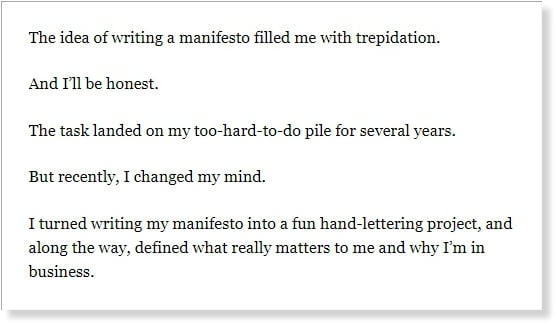
Evaluation:
When I start editing, I have already revised my draft, so I know the content works and the overall flow is fine. My main task is to look for small content issues.
The key change I make here is to take out the reference to a fun hand-lettering project. While this comment is true, it distracts from the key message: my realization that manifestos are more important than I had previously thought.
A story only needs to include essential details—anything non-essential may distract readers and slow them down.
Once I decided to focus the opening on the importance of manifestos, I increased the contrast with my previous thinking (that manifestos are not so important) by adding the sentence: “My excuse was: No time for such ‘pet projects.’”
The other changes are minor:
- In the initial version, I mention that the task landed on my too-hard-to-do pile for several years. However, I’m not sure whether the reference “the task” here is clear enough for hasty readers, so I make it specific and change it to “writing a manifesto.”
- I replace “landed” with “languishing” because it’s a more accurate description: a task lands only once on a to-do list, and then might stay, linger, or languish for days, months, or years.
- I add an opening sentence: “A business manifesto?!??” because I like starting with ultra-short or broken sentences and these three words with the “?!??” seem to add a little flair. Like many edits, it’s a personal choice. It doesn’t make the content better, but different—more like me.
Final version of my opening paragraph:
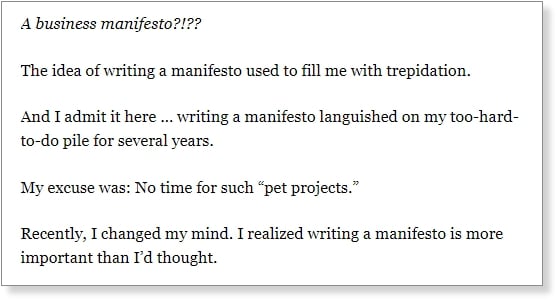
If you read both versions aloud, you’ll notice the rhythm changed, too. My drafts often sound choppy.
Example 2: The “Why” section
My opening paragraphs usually explain how readers will benefit from the advice in the post.
However, in this case, I want to explain the “Why” in more detail, so I created a separate paragraph about the benefits of writing a manifesto. This is the draft version:
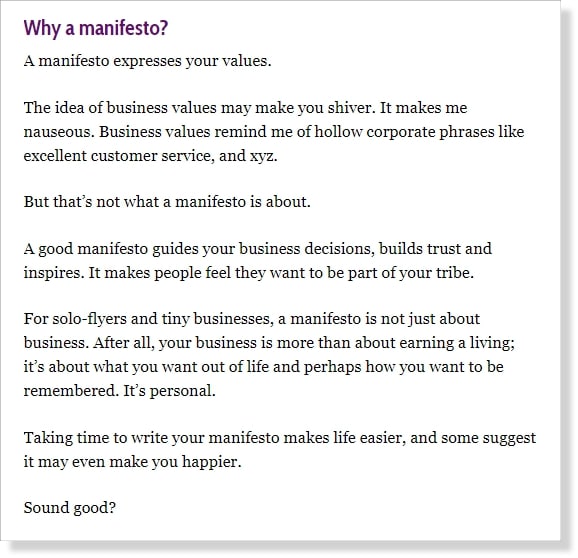
Evaluation of the draft:
Again, this version is pretty good—I’ve ironed out the big issues already. However, I can make a stronger case for writing a manifesto, and I can adjust the tone to make this paragraph more engaging and to make it sound more like me.
These are the key changes:
- The draft still includes the letters “xyz.” Now, it’s time to add examples of hollow corporate phrases, such as “passion for innovation” and “authenticity.”
Writing “xyz” or “TK” (to come) in a draft keeps me in a writing flow so I can write faster.
- “Become part of your tribe” is perhaps a slightly vague buzzword, so I add examples to make this more concrete—“to become your client, to read your blog, to partner up for projects, to buy and own your products, to act on your advice.”
- The next short paragraph feels a little weak:
For solo-flyers and tiny businesses, a manifesto is not just about business. After all, your business is more than about earning a living; it’s about what you want out of life and perhaps how you want to be remembered. It’s personal.
I extend this paragraph into three paragraphs and include questions to make it more engaging.
Here’s the final version:
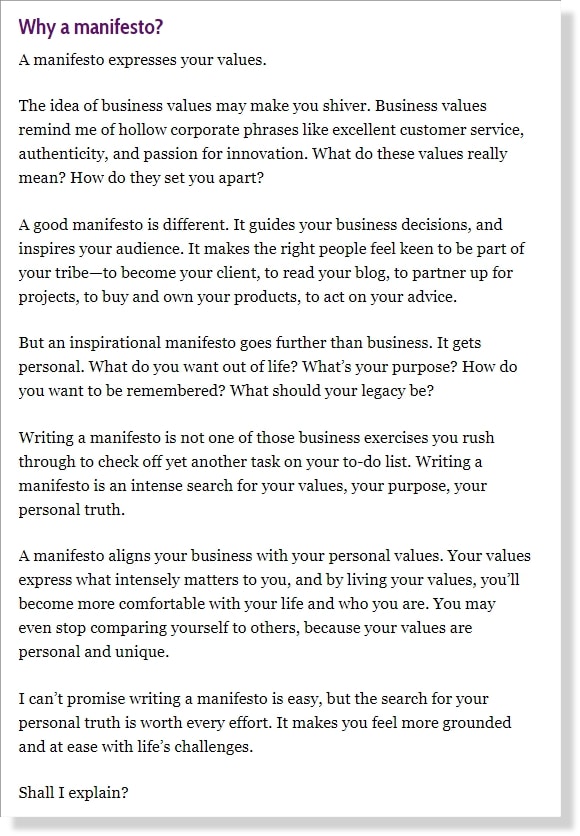
Example 3: The first tip
After explaining the benefits of a business manifesto, the real “meat” of the post starts—the tips helping you write your own manifesto.
Here’s the draft paragraph for the first step:
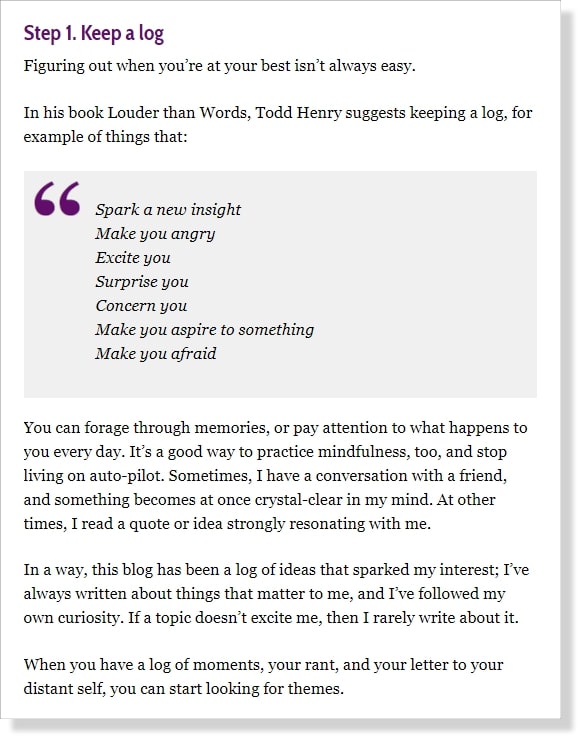
Evaluation:
- This paragraph starts rather abruptly. I don’t explain why you need to be at your best, but state that it’s hard to figure out. I change this first sentence and add more questions to create a conversational tone.
- I change the order of the last few sentences, so the flow is smoother: I first explain how Henry suggests to keep a log, and then I explain what’s in my log—adding examples so this feels less abstract.
Here’s the final version:
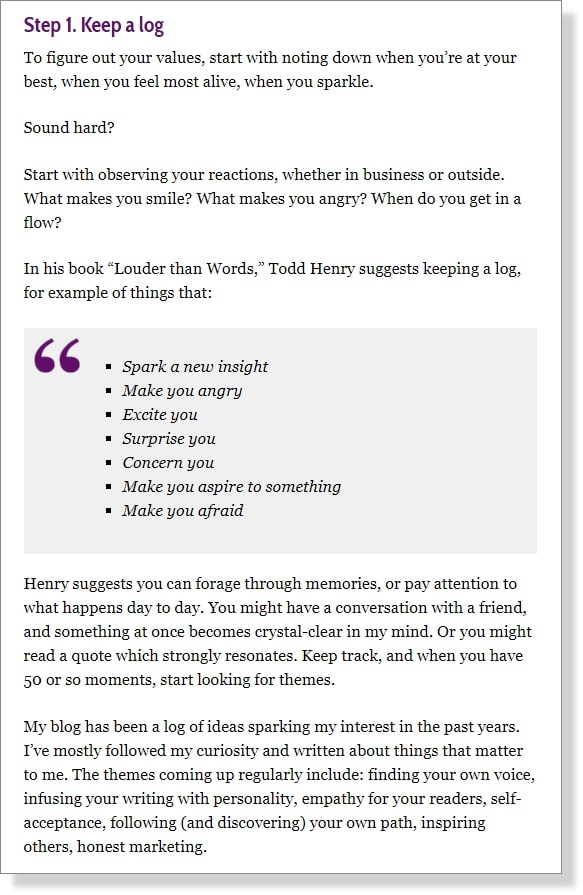
Don’t keep polishing your words forever
Don’t endlessly um and ah about each word and each comma.
Instead, give yourself a time limit, and focus on the most important editing tasks. For instance:
- A product description or “hire me” page aims to communicate your sales messages quickly, so it’s important to be concise—focus on cutting the flab
- A blog post aims to entice visitors to read your whole page—focus on your headline, subheads and opening paragraph to encourage visitors to read instead of skim your article
Turn self-editing into a fun exercise
In most cases, editing is not about being right or wrong.
Instead, your edits are an opportunity to change your writing voice, to make your content sound more like you.
So, don’t take this task overly serious. Play with a few words. Add a couple of questions. Perhaps chop long sentences in two.
How do the changes sound? Do they feel good?
Don’t try to find the perfect words. Perfection doesn’t exist.
Instead, find the words that shine.
The words that make your heart sing.
PS Thank you to Richard Padgett for inspiring this post, and thank you to Amanda and Andy at OrbitMedia for nudging me to write it.
Recommended reading on self-editing:
The 5-step revision process for writers
How to eliminate weak words from your writing
How to write clearly and concisely


Henneke you are an inspiration.Although my books have been published, I have never given a thought to fine editing. I suppose my works are more technical,and the publisher’s editors undertake this awesome task.
You are teaching me so much and I am indebted to you.
Thank you so much.
Yes, your publisher’s editors probably make similar changes.
I’m glad you still found this post useful. Thank you for stopping by, Cecilia.
Hey Henneke,
Great post.
“Editing is like sandpapering away small blemishes so your content feels smooth to readers.”
I LOVE this line. Sums up editing 100%.
Throughout the years I’ve read your blog and followed your tips and advice, editing is something I STILL have issues with. Even when I leave the draft for a few days, and then come back to it, it’s still not polished.
Clearly, I’ll need to work on this more.
– Andrew
I think that’s one of the challenges with editing. It’s so easy to feel it’s never good enough as we can always edit more. So, it’s also important to find the right moment to be satisfied with our content and decide we’ve edited enough.
Thank you for stopping by again, Andrew. As always, I appreciate it.
Just wanted to say you’re amazing. I keep improving considerably each time I read your post. Your blog is a complete best seller writing book. 🙂
Thanks for your contributions to help me improve my life. You’re the best.
Happy writing, Eze. Thank you for your compliment and for stopping by.
Your first drafts are still better than my final ones! I’m looking forward to putting all of this into practice – I’ve always preferred editing to the actual writing so I need to spend more time on it.
I’m also most in my element when editing! But I’ve learned that when I take the pressure of writing first drafts, they’re actually not so bad to write anymore, and I can look forward to editing later 🙂
Just to be clear, the drafts I published here aren’t really “rough” drafts, I did some editing while writing the first draft already (I often do some editing while writing the first draft – as long as it doesn’t slow me down too much).
One of the smartest and crisp headlines I have came across this week, I was compelled to click and read and the content was equally compelling as the headline. Self editing is tough but you are right, turning it into a fun exercise would make it less tedious.
I’ve found that some people hate writing first drafts, and they love editing. And other people are okay with writing first drafts, they might even enjoy it, but they find editing tedious—like you. I’m the opposite: I enjoy the process of editing more than writing the first draft.
As usual, a wonderful post jam-packed with value, Henneke. 🙂 Good point on over-editing, I feel like that’s where I’m struggling… 😀 Though it helps to leave the text for at least a day and then come back to it – for me, that usually cuts the editing time in half.
I hear you. I can edit endlessly, too.
If possible, I try to write on day one, and spread the editing over day two and three, but I often end up doing all editing on the same day (but not on the day that I write my first draft!).
Hello Henneke, I desire to be an author and wanted to start my blog. I have already created the one but something hold me back.
Topic! Fear of review!! Time!!! Consistency!!!!
I feel lost and leaves it!!
The funny part is your post reminds me of my dream and I feel like starting on it ASAP. Let me promise I will start my blog and will share with you.
Thanks for writing and motivating me. Cheers.
It makes me happy to read you feel motivated to (re)start your blog. Go for it!
Happy blogging 🙂
I assume I leap from side to side like a ping-pong ball between under editing and over enhancing. I think it’s worry of being hit with the aid of the ping-pong paddle that slows my writing the most.
Worry about whether we do it right is probably one of the most common reasons why our writing slows down. It really pays to learn how to silence your inner critic so you can get on with writing.
Happy writing, Micheal and thank you for stopping by.
Hello again Henneke, and thanks for an insightful editing blog. I especially like Tip3. You show how to move from Todd Henry’s advice into concrete examples of priorities for your manifesto.
Translating professional advice to achieve a specific outcome in the real-world can be tricky. The translation should remain consistent with the advice.
For example, I need to cite best care practices when I write for family carers of people with dementia. However, I must also show how professional care methods in nursing homes are adaptable to a family carer’s experience in the home – a very different environment.
From now on I will use Tip 3 in my endless rounds of editing!
Thank you again from sunny but cold Sydney.
Adding concrete examples often makes a major impact on writing—I see this in my courses a lot. The examples turn abstract advice into doable tips; people can visualize how they’d actually implement your suggestions.
I like your point on being careful that professional care methods can’t always be translated exactly into a family carer’s experience at home.
It sounds like you’re making a lot of progress with your book! 🙂
This is a keeper. I love the “xyz” example so you can keep powering through rather than getting hung up on a detail that can be filled in later. It’s illuminating to watch a master at work and get inside your head on your process.only wish my first drafts looked as good, never mind the finished products! Oh, wait… that would require me to write the first draft! LOL!?
Yeah, I was wondering whether this was a suitable first draft to show because it was pretty good already. But if there’s too many changes to make, then it becomes sort of hard to explain what to do, too.
I’ve found that the more focused I am while writing my first draft, the better the first draft becomes. My first drafts used to be terrible; and when I’m trying to work when I’m tired, my drafts are still terrible – the grammar is all wrong, Dutch words sneak in, and I’m rambling.
Since I started writing my first drafts first thing in the morning, my concentration level is higher and my writing is a lot better; it saves a lot of time editing.
I want to be a “piercing precision” kinda gal. And I think I love the word “languishing”. It’s such an 18th century sounding word. Languor–how often we go there! 🙂
I think I bounce back and forth like a ping-pong ball between under editing and over editing. I think it’s fear of being hit by the ping-pong paddle that slows my writing the most.
Thanks for the idea of dealing with only the most important tasks, which happen to be the facets I come closest to forgetting entirely, which gives me new direction. Again!
Ha, that’s a good point. I’m definitely in the over-editing camp!
I’m not quite an obsessive editor (although some might disagree). I guess I just enjoy the editing and like to play with the words and the rhythm.
Languor – I love that word, too. Reminds me of lazy, hot summer evenings.
Yeah. But do you even HAVE those in Holland? 😀
Yes, we do get lazy hot summer evenings in Holland sometimes. Probably more often than in the Northwest of England! Having said that, so far this summer has been sunnier than any summer I remember since we live here. I’m not complaining! 🙂
Thanks so much Henneke, I have always had the passion for writing without ideas capable of getting me started. I believe this post would serve as a great guide for me. Thanks again!
I’m glad you found it useful, Tracy.
If you struggle to get started, you might find this post useful, too: https://www.enchantingmarketing.com/writing-shitty-first-drafts/
Let me know if you have any specific questions?
Here’s my advice for anyone reading this that is NOT on Henneke’s email list: SIGN UP NOW! You simply do not know when she will pop into your inbox with advice that is exactly what you need at that moment. It has happened to me over and over for several years, each time improving the way I write. I firmly believe that her advice has made me a better writer, and that part of my success is due to her guidance. Thanks, Henneke for another great post!
Thank you so much, Melinda. Your comment put a smile on my face 🙂
Happy writing!
Hi Henneke,
Another helpful piece from you.
I don’t know what your opinion is on having an editor. I have one and sometimes I don’t know how far to let her change my pieces. Sometimes I feel like she is erasing my style and adding hers.
An editor can be very useful as they often see things that we, as writers, miss. Using an editor can also save you time.
But, as a writer, you’re always in charge. It’s your content and your voice, so it’s your decision whether you accept an editing suggestion or not.
Try to understand why an editor made a change, and then decide whether you like it or prefer your original version. Some editing suggestions are a matter of personal preference, and your personal preference may differ from your editor’s.
“Some editing suggestions are a matter of personal preference, and your personal preference may differ from your editor’s.”
That’s the best advice I have received on how to deal with editing help.
Thanks very much!
Hi Henneke,
I’m so pleased you’ve written about your editing process. It’s wonderful to be able to compare the versions, see your changes and learn why you made them.
I love how you accept the choppiness in your early drafts and move on – it really reinforces what you say about ignoring your inner critic.
How long do you leave between the writing/revising/editing stages? What proportion of your writing time do you spend on editing?
Thank you for inspiring this post, Richard. I can’t remember when you mentioned it, but it must be over a year ago. Sorry to have kept you waiting so long 🙂
With most of my blog posts, I don’t do a lot of revising as the structure I follow is relatively simple. (More personal posts are an exception; I often freewrite those and do more revision.)
I usually choose an idea on day 1, and jot down a few ideas on what to include in the post; then on day 2, I write a first draft; on day 3, revision if required plus the first round of editing; on day 4, editing round 2, proofreading plus formatting. But I don’t adhere to this plan strictly. Sometimes I start editing before I’ve finished a draft because I feel stuck, and sometimes I don’t start early enough, so I write & edit in two days.
I probably spend roughly one third of my time on writing, and two third on editing. I’m guessing this might be the opposite of what most people do. I just love editing 🙂
Writing books is different—I do more outlining and a lot more revising with moving text between chapters, reordering and merging chapters, and even creating new chapters. I use the writing process to formulate my thoughts and to get to grips with a topic (even if I’ve already written several blog posts about it). I find the book writing process a lot more demanding!
Hi Henneke,
Thanks for such a detailed reply. Yes, it’s been a while since we first discussed this post – but well worth the wait!
The biggest problem I encounter with editing my own work is that I fall into the trap of doing it as I go along. By the time I complete a draft I often find it hard to look at it again with fresh eyes.
I love the efficiency in your method. One of the “aha” moments from your before-and-after examples is that I can see how valuable it is to observe distinct writing phases and to trust the process.
I know you’ve talked about this here in the past, but seeing how this works in practice for you has been very revealing.
I’m going to change my ways!
I do some editing while writing, too, but mainly to change the flow or content.
I try to find the right speed—writing a first draft too fast makes revision a pain, but writing too slow can make me lose my train of thought. It feels like I need to keep my mind focused on the relatively big picture so I can write a good first draft at a decent speed (and then as you say, trust that I’ll sort out the rhythm and word choice later).
I don’t think there’s one ideal way to write!
Don’t keep polishing your words for ever. Forever.
Good catch!
I’ve corrected it. I’m glad I’m not writing about proofreading 😉